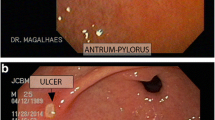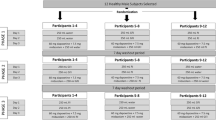Abstract
Objective
Induction of CYP3A by St. John’s wort (SJW) extracts with high hyperforin (HYF) content is well described. Since SJW products vary in the amount of HYF and other main constituents, the aim of the study was to evaluate the effect on CYP3A function of SJW preparations with a range from very low to high HYF content.
Methods
Forty-two male, healthy volunteers were randomized into six parallel SJW medication groups with varying composition especially with regard to HYF content. Midazolam plasma concentration profiles were characterized after a single oral dose of 7.5 mg midazolam on the day before and on the 14th day of SJW medication.
Results
All SJW preparations tested resulted in a decrease in midazolam AUC, although the extent of the effect differed. The extract LI 160 (HYF 41 mg/day) decreased midazolam AUC0–12h by 79.4% (95% CI −88.6; −70.1), which was significantly greater than the effect by any other medication (p<0.05). SJW powder tablets 2.7 g/day (HYF 12 mg/day) resulted in a midazolam AUC0–12h decrease of 47.9% (95% CI −59.7;−36.2), while 2.7 g/day SJW powder tablets that were almost devoid of HYF (0.13 mg/day) reduced midazolam AUC0–12h by only 21.1% (95% CI −33.9; −8.3). Considering all six SJW medications tested, the extent of midazolam AUC decrease correlated significantly with increasing HYF dose (r=−0.765, p<0.001), but not with hypericin dose (r=−0.067; p=0.673).
Conclusion
The extent of induction of CYP3A varies among St. John’s wort products and depends on hyperforin dose.

Similar content being viewed by others
References
Bjornsson TD, Callaghan JT, Einolf HJ, Fischer V, Gan L, Grimm S, Kao J, King SP, Miwa G, Ni L, Kumar G, McLeod J, Obach SR, Roberts S, Roe A, Shah A, Snikeris F, Sullivan JT, Tweedie D, Vega JM, Walsh J, Wrighton SA (2003) The conduct of in vitro and in vivo drug drug interaction studies: a PhRMA perspective. J Clin Pharmacol 43:443–469
Butterweck V, Nahrstedt A, Evans J, Hufeisen S, Rauser L, Savage J, Popadak B, Ernsberger P, Roth BL (2002) In vitro receptor screening of pure constituents of St. John’s wort reveals novel interactions with a number of GPCRs. Psychopharmacology 162:193–202
Butterweck V (2003) Mechanism of action of St. John’s wort in depression—What is known? CNS Drugs 17:539–562
De los Reyes GC, Koda RT (2002) Determining hyperforin and hypericin content in eight brands of St. John’s wort. Am J Health Syst Pharm 59:545–547
De Vries JX, Rudi J, Walter-Sack I, Conradi R (1990) The determination of total and unbound midazolam in human plasma. A comparison of high performance liquid chromatography, gas chromatography and gas chromatography/mass spectrometry. Biomed Chromatogr. 4:28–33
De Wildt SN, Kearns GL, Hop WC, Murry DJ, Abdel-Rahman SM, van den Anker JN (2002) Pharmacokinetics and metabolism of oral midazolam in preterm infants. Br J Clin Pharmacol. 53:390–392
Draves AH, Walker SE (2003) Analysis of the hypericin and pseudohypericin content of commercially available St. John’s wort preparations. Can J Clin Pharmacol 10:114–118
Dresser GK, Schwarz UI, Wilkinson GR, Kim RB (2003) Coordinate induction of both cytochrome P4503A and MDR1 by St. John’s wort in healthy subjects. Clin Pharmacol Ther 73:41–50
Dürr D, Stieger B, Kullak-Ublick GA, Rentsch KM, Steinert HC, Meier PJ, Fattinger K (2000) St. John’s wort induces intestinal p-glycoprotein/MDR1 and intestinal and hepatic CYP3A4. Clin Pharmacol Ther 68:598–604
Gaedcke F (1997) Johanniskraut und dessen Zubereitungen. Dtsch Apoth Ztg 137:3753–3757
Henderson L, Yue QY, Bergquist C, Gerden B, Arlett P (2002) St. John’s wort (Hypericum perforatum): drug interactions and clinical outcomes. Br J Clin Pharmacol 54:349–356
Hölzl J, Ostrowski E (1987) Johanniskraut (Hypericum perforatum): HPLC-Analyse der wichtigen Inhaltsstoffe und deren Variabilität in einer Population. Dtsch Apoth Ztg 127:1227–1230
Komoroski BJ, Zhang S, Cai H, Hutzler JM, Frye R, Tracy TS, Strom SC, Lehmann T, Ang CYW, Cui YY, Venkataramanan R (2004) Induction and inhibition of cytochromes P450 by the St. John’s wort constituent hyperforin in human hepatocyte cultures. Drug Metab Dis 32:512–518
Mai I, Bauer S, Perloff ES, Johne A, Uehleke B, Frank B, Budde K, Roots I (2004) Hyperforin content determines the magnitude of the St. John’s wort–cyclosporine drug interaction. Clin Pharmacol Ther 76:330–340
Mannel M (2004) Drug interactions with St. John’s wort—mechanisms and clinical implications. Drug Safety 27:773–797
Melzer M, Fuhrken D, Kolkmann R (1998) Hyperforin im Johanniskraut—Hauptwirkstoff oder nur Leitsubstanz? Dtsch Apoth Ztg 138:56–62
Miekisch W, Fuchs P, Berg A, Nöldge-Schomburg G, Drewelow B, Mundkowski R (2003) An improved GC/MS method for the determination of midazolam in human plasma. [abstract] Int J Clin Pharmacol Ther 4:560
Moore LB, Goodwin B, Jones SA, Wisely GB, Serabjit-Singh CJ, Willson TM, Collins JL, Kliewer SA (2000) St John’s wort induces hepatic drug metabolism through activation of the pregnane X receptor. Proc Natl Acad Sci USA 97:7500–7502
Mueller SC, Uehleke B, Woehling H, Petzsch M, Majcher-Peszynska J, Hehl E-M, Sievers H, Frank B, Rithling A-K, Drewelow B (2004) Effect of St. John’s wort dose and preparations on the pharmacokinetics of digoxin. Clin Pharmacol Ther 75:546–557
Ring BJ, Patterson BE, Mitchell MI, Vandenbranden M, Gillespie J, Bedding AW, Jewell H, Payne CD, Forgue ST, Ecksetin J, Wrighton SA, Phillips DL (2005) Effect of tadalafil on cytochrome P450 3A4-mediated clearance:studies in vitro and in vivo. Clin Pharmacol Ther 77:63–75
Rosenberger WF, Lachin JM (2002) Randomization in clinical trials. Wiley, New York
Streetman DS, Bertino Jr JS, Nafziger AN (2000) Phenotyping of drug-metabolizing enzymes in adults: a review of in-vivo cytochrome P450 phenotyping probes. Pharmacogenetics 10:187–216
Wang Z, Gorski C, Hamman MA, Huang S-M, Lesko LJ, Hall SD (2001) The effects of St. John’s wort (Hypericum perforatum) on human cytochrome P450 activity. Clin Pharmacol Ther 70:317–326
Wentworth JM, Agostini M, Love J, Schwabe JW, Chatterjee VKK (2000) St. John’s wort, a herbal antidepressant, activates the steroid X receptor. J Endocrinol 166:R11–R16
Wurglics M, Westerhoff K, Kaunzinger A, Wilke A, Baumeister A, Dressman J, Schubert-Zsilavecz M (2001) Comparison of German St. John’s wort products according to hyperforin and total hypericin content. J Am Pharm Assoc 41:560–566
Zanoli P (2004) Role of hyperforin in the pharmacological activities of St. John’s wort. CNS Drug Rev 10:203–218
Zhou S, Chan E, Pan S-Q, Huang M, Lee EJD (2004) Pharmacokinetic interactions of drugs with St John’s wort. J Psychopharmacol 18:262–276
Acknowledgements
We thank Jana Spaller for organizational assistance, Grit Haase for assistance in taking blood samples and Gunda Hahn, Annette Berg, Patricia Fuchs, Liane Krause and Antje Schümann for processing of samples. The study was supported by funding from companies in Germany that have an interest in St. John’s wort. These companies are: Kneipp Werke, Würzburg; MCM Klosterfrau GmbH, Cologne; Phytolab GmbH, Vestenbergsgreuth; Bad Heilbrunner GmbH, Bad Heilbrunn; Merz Consumer Care GmbH, Frankfurt; GlaxoSmithKline GmbH, Bühl; Salus-Haus, Bruckmühl.
Author information
Authors and Affiliations
Corresponding author
Additional information
The study was started after approval by the ethics committee of the University of Rostock and was performed according to the national laws of Germany.
Rights and permissions
About this article
Cite this article
Mueller, S.C., Majcher-Peszynska, J., Uehleke, B. et al. The extent of induction of CYP3A by St. John’s wort varies among products and is linked to hyperforin dose. Eur J Clin Pharmacol 62, 29–36 (2006). https://doi.org/10.1007/s00228-005-0061-3
Received:
Accepted:
Published:
Issue Date:
DOI: https://doi.org/10.1007/s00228-005-0061-3




